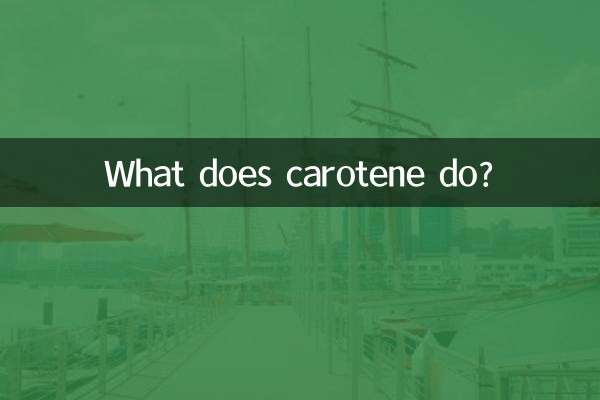What vegetables do patients with cerebral infarction eat? 10 recommendations and dietary precautions
Cerebral infarction (cerebral infarction) is a disease in which brain tissue is ischemic and hypoxic due to obstruction of cerebral blood vessels. Dietary conditioning is crucial for recovery and prevention of recurrence. Vegetables are rich in vitamins, minerals and dietary fiber, which can help control blood pressure, blood lipids and improve blood vessel health. The following is a compilation of the cerebral infarction diet topics that have been hotly discussed on the Internet in the past 10 days. Combined with medical advice, we recommend suitable vegetables and scientific combination methods for patients with cerebral infarction.
1. Top 10 vegetables recommended for patients with cerebral infarction

| vegetable name | Core functions | Food recommendations |
|---|---|---|
| spinach | Rich in folic acid and potassium, lowers homocysteine and protects blood vessels | Blanch to remove oxalic acid, 3-4 times a week |
| Broccoli | Sulfur compounds, antioxidants, reduce vascular inflammation | Steam to retain nutrients, 100-150g each time |
| celery | Apigenin lowers blood pressure, dietary fiber lowers blood lipids | Juice or serve cold dishes, avoid high-salt cooking |
| Eggplant | Anthocyanins enhance blood vessel elasticity and vitamin P prevents bleeding | Cook with less oil and avoid frying |
| Bitter Melon | Bitter melon saponin regulates blood sugar and prevents complications | Soak slices in water to remove bitterness, twice a week |
| carrot | Beta-carotene is an antioxidant and protects vascular endothelium | It is recommended to eat cooked food with oil for easier absorption. |
| black fungus | Polysaccharides anti-thrombosis, plant colloids clear blood vessels | Soak and then serve cold or stewed |
| onion | Contains prostaglandin A, dilates blood vessels and improves blood circulation | Eat raw or stir-fry for a short time |
| asparagus | Rutin strengthens capillaries and lowers cholesterol | Blanched and then boiled to retain the crispy texture |
| pumpkin | High potassium and low sodium, regulate blood pressure, pectin delays sugar absorption | Steaming replaces some staple foods |
2. Three principles of diet for patients with cerebral infarction
1.Low salt and low fat: Daily salt intake ≤5g, avoid pickled vegetables; use olive oil instead of animal oil for cooking.
2.High fiber and high potassium: Choose vegetables with dietary fiber >3g/100g, such as pea sprouts, kale, etc.
3.Diversified matching: Daily intake of more than 5 kinds of vegetables of different colors, totaling 300-500g.
3. Vegetables that need to be eaten with caution
| vegetable type | Potential risks | alternative |
|---|---|---|
| Pickled products (sauerkraut, pickled cucumbers) | High sodium induces hypertension | Choose fresh or frozen vegetables |
| High-starch foods (potatoes, yams) | Too much can easily raise blood sugar | Control portions and reduce staple foods |
| Spicy (raw garlic, chili) | May affect drug metabolism | Delicatessen or lightly seasoned |
4. Popular questions and answers: 3 questions that patients are most concerned about
Q1: Can I eat mushrooms after cerebral infarction?
A: Yes. Shiitake mushrooms, king oyster mushrooms, etc. are rich in fungal polysaccharides, which help regulate immunity, but they need to be cooked thoroughly.
Q2: Are vegetables more nutritious when eaten raw?
A: Some vegetables (such as cucumbers and lettuce) can be eaten raw, but those with weak digestive function are recommended to blanch them to soften the fiber.
Q3: Can drinking vegetable juice replace eating vegetables?
A: No. Juicing will result in loss of dietary fiber, so it is recommended to focus on whole vegetables and supplement with juice.
5. One-week recipe reference (vegetable part)
| breakfast | lunch | dinner |
|---|---|---|
| Celery and millet porridge + cold fungus | Stir-fried shrimps with broccoli + pumpkin rice | Asparagus and tofu soup + steamed eggplant |
| Carrot Egg Pancake + Spinach Juice | Bitter Melon Stir-fried Beef + Purple Sweet Potato | Scrambled eggs with onions + oatmeal |
Note: The above content is based on the guidelines of the nutrition department of tertiary hospitals and the "Dietary Guidelines for the Prevention and Treatment of Stroke in China". The specific diet needs to be adjusted according to individual circumstances. It is recommended to formulate a plan under the guidance of a doctor.

check the details

check the details